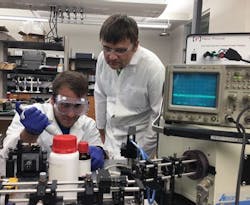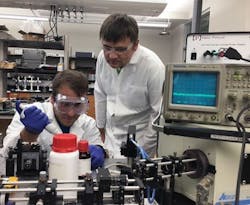Optical detection method could improve diabetes management
Researchers at Texas A&M University (College Station, TX) have developed an optical detection method for monitoring glucose that is based on how it absorbs a specific type of light. The method could someday eliminate the need for the painful, invasive finger-prick tests that those with diabetes rely on to monitor their condition.
Related: Smartphone-enabled device detects diabetes in a saliva sample
Using optical technology that essentially sends a twisting, directional type of light at a glucose-containing sample, a team of researchers led by Vladislav Yakovlev, a professor in Texas A&M’s Department of Biomedical Engineering, has been able to accurately detect glucose concentrations by measuring how glucose absorbs this light at a molecular level. His findings may translate into a more effective means of diabetes management. He says that standard glucose-monitoring techniques such as finger-prick methods cannot achieve continuous monitoring of a patient’s blood-glucose levels—and because patients are advised to self-administer these invasive tests at least three times a day, many of them don’t comply with this instruction, he notes.
Though the optical detection technology being developed by Yakovlev and his team is still in its infancy, the technology might one day be implemented in devices such as smart watches and bracelets where it would provide patients with hassle-free, continuous monitoring and alerts when their blood-glucose levels slip to dangerous levels. For now, the technology is being refined in the laboratory with the hopes of one day moving to human trials if results continue to be positive, Yakovlev says.
The technology works by measuring how individual glucose molecules absorb a specific wavelength of light that is characterized as right and left circular-polarized, Yakovlev explains. By measuring the specific manner in which glucose molecules vibrate and absorb this light, Yakovlev is able to differentiate the molecules from their surroundings and calculate glucose concentrations. Its measurable effect, he says, is because of a geometric property of the glucose molecule known as chirality. Glucose's chiral structure, which is a result of its arrangement of atoms, means that its molecule cannot be superimposed over its mirror image.
This specificity enables Yakovlev to discriminate glucose molecules from other surrounding biological molecules. For example, he explains, the large presence of water in tissue has typically created a problem when it comes to attempting to detect glucose with optical technology because water also absorbs light and in doing so masks the presence of glucose. In addition, protein molecules can appear similar, which necessitates factoring in of additional variables into detection technology to obtain reliable data. To that end, Yakovlev's technology overcomes these obstacles by reaching the proper penetration depths and producing a unique, measurable effect that, in a sense, removes the background noise from the picture, leaving behind the glucose signal.
The research was presented at the SPIE Photonics West 2016 conference (held February 13-18 2016, in San Francisco, CA); for more information, please visit http://proceedings.spiedigitallibrary.org/proceeding.aspx?articleid=2519354&resultClick=1.

